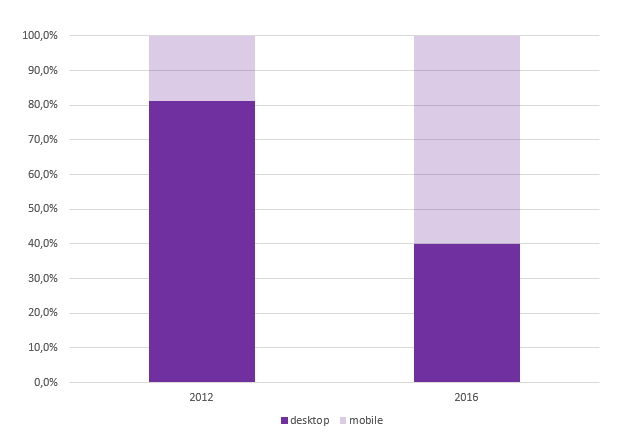When we think about conversion rate optimisation, the goal is often to improve conversion on your website. But what about improving data collection? In the ever growing complexity of data collection in a multi-device world, I think it is time for tests that focus on data collection (and data-first UX). We need it to truly understand the user.
Device-first is exclude-first
For a long time, websites were made for the desktop because we only accessed the web through desktops. The introduction of the iPhone slowly introduced a change. User experience started focusing on mobile and along came mobile-first design. Right now, I think we’ve past the time where any device-first approach will work. Let me explain with some data.
I’ve compared the data of some of our clients to see how the mobile-desktop ratio has changed in 4 years. As you can see in the graph below, in 2012 a desktop-first approach optimised the website for 81% of traffic, whereas in 2016, it’s only 40%. If you’ve changed to a mobile-first approach to UX in 2016, your focus has changed from 40% of traffic to 60%.

Graph showing desktop and mobile sessions in 2012 and 2016.
The problem for me is that any device-first approach focusses on optimising a design for a subset of your audience, not the whole group. Because of this, the experience is improved for only a part of your users.
Why you need to ditch device focus for data focus
With a focus on data over design, you focus on improving the experience for everyone rather than a subset of users. Let’s look at two examples:
-
Interface: you have an idea for a startup and decide to set up a landing page. On the page, you have a spot dedicated to a big bright green SUBSCRIBE button. I go to your site on my laptop and subscribe. If I would visit the website again, on the same device or on a different one, the website will still show me that big bright green subscribe button. Even though I’ve subscribed already.
-
Marketing: I’m at home, browsing the web, looking for a gift for one of my friends. I browse a bit, find it, and save the link. Later on, I open the link in another device and buy the product. A decent marketing agency will make sure you’re excluded from remarketing on the device I used to make the purchase. But exclusion on all my other devices probably won’t happen.
Making sure that you’re able to recognise users on as many devices as possible will give you the data to truly improve the user experience and to truly make the web a better, friendlier place for users.
How to optimise for better data collection
With device-focused UX, data collection has focussed on collecting user behaviour per device. In our multi-device world, the true value comes when we start identifying users across devices. But this is easier said than done. First of all, you’ll need to know what your potential customer identifiers are. They come in two flavours:
- customer identifiers for users with a login, e.g. a customer id.
- customer identifiers for users without a login, these are often recognisable by information a user fills out, e.g. email or address.
If you know your identifiers, it’s time to optimise for the collection of these identifiers. Personally, I think there are two main categories to optimise in:
- Customer journey position: try to collect the cusomter identifier as early on in the customer journey as possible.
- Making input mandatory:
- if the identifier input field is flexible (e.g. filling out your address or hometown in a store locator) change it to make it capture the data you want.
- Do you have an optional input field (e.g. a phone number in a form), make it mandatory.
When you’ve identified your customer identifiers, you’ll need to set the goal for your optimisation efforts.
So, what metric do I optimise for?
Here is where it gets interesting: you’ll need to optimise for no impact on website conversion. If you can improve the collection of customer identifiers without negatively impacting your sales, you have yourself a successful test.
If you have an automated system that uses customer identification (e.g. for cross-device conversion attribution), you might even consider the benefits of the improved data over a negative effect on conversion rate. And even if the conversion rate drops, the experience of the converted users may improve, and it might result in a more loyal user base and a higher customer lifetime value.
Put data first
In the end, it all comes down to putting data first. In the growing complexity of our digital lives, showing the right message at the right moment (whether it’s onsite, in ads or offline) will become harder and harder. Improving your understanding of the user is the first step. To get a better understanding of a user, you’ll need good user data and a complete view of a user’s journey.
Start optimising for better data today.







Leave a Reply
You must be logged in to post a comment.